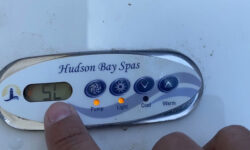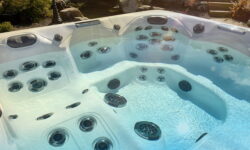As summer rolls around, the thought of plunging into steaming water can be less than appealing. But can you turn your hot tub into a cool oasis for the hot summer days?
Yes, you can make a hot tub cool in the summer. You can simply reduce the temperature settings on the hot tub’s heater or turn it off completely. The water in the tub will naturally cool down to the surrounding temperature. You can also use a spa cooling system or add ice to the water for a quicker cool down.
In this article, we will explore the possibilities of making your hot tub cool in the summer.

Quick Navigation
- Understanding the Basics of Hot Tub Temperature Control
- Steps to Turn Your Hot Tub Into a Cool Pool
- Is There a Minimum Temperature For a Hot Tub?
- The Role of Hot Tub Covers in Temperature Regulation
- Maintenance Tips for a Cool Hot Tub in Summer
- Health and Safety Considerations for Cooling Your Hot Tub
- Frequently Asked Questions
- Conclusion
Understanding the Basics of Hot Tub Temperature Control
Before you can effectively manage your hot tub’s temperature, it’s essential that you understand the basics of hot tub temperature control. Hot tubs are typically designed to maintain a temperature range of 100-104°F. It’s the water heater and the thermostat that work together to regulate this.
Your tub’s heater is its engine, transforming energy into heat. On the other hand, the thermostat is the brain behind the operation. It’s responsible for signaling the heater when to turn on and off, based on the water temperature it detects. If it’s colder than the set temperature, the thermostat triggers the heater to start warming the water, and vice versa.
But here’s where you come in. You have the power to manipulate the thermostat and set it to your preferred temperature. So, in summer, you can definitely turn down the heat and enjoy a refreshing dip instead of a hot soak.
However, you need to remember that turning down the temperature too much can strain the system. A drop of more than 20 degrees might cause damage. It’s all about finding that sweet spot that’s comfortable for you and safe for your hot tub.
Steps to Turn Your Hot Tub Into a Cool Pool
You’re ready to transform your hot tub into a cool pool for the summer, and with these steps, it’s easier than you might think. Let’s dive right into the process.
Firstly, turn off your hot tub’s heater. You won’t need it in the sweltering summer heat.
Next, drain your tub completely. It’s an essential step in the transition process. Once it’s empty, give it a thorough clean to eliminate any residues or contaminants that could affect your cool tub experience.
After the cleaning, partially refill the tub with cold water. Now, it’s time for the crucial step: adjusting the temperature.
Set your hot tub’s temperature to your desired cool pool temperature, typically between 70-85 degrees Fahrenheit. Remember, you can always adjust it based on your comfort level. You can also consider adding a pool chiller if you live in an area with extreme heat.
Lastly, monitor the water chemistry regularly. A cool pool has different requirements compared to a hot tub. Adjust the pH, alkalinity, and sanitizer levels accordingly to ensure a safe and enjoyable cool pool experience.
Is There a Minimum Temperature For a Hot Tub?
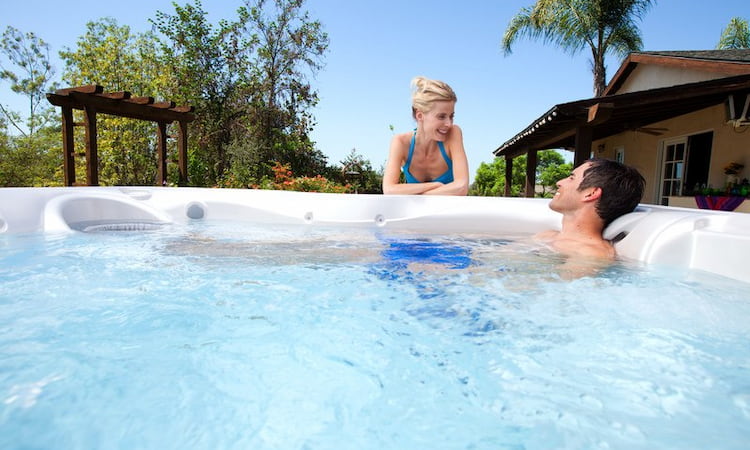
The minimum temperature a hot tub can go varies depending on the brand and model, but generally, it can be set as low as 26 degrees Celsius or 80 degrees Fahrenheit.
This is because most hot tubs are designed to provide a warm and relaxing experience, and temperatures below this may not offer the same comfort and therapeutic benefits.
However, it’s important to remember that the minimum temperature should never be so low that it poses a risk of hypothermia. The ideal hot tub temperature for most people is between 38 and 40 degrees Celsius or 100 to 104 degrees Fahrenheit.
Also, maintaining a consistent temperature is recommended to avoid unnecessary wear and tear on the hot tub’s heating system
The Role of Hot Tub Covers in Temperature Regulation
In regulating the temperature of your hot tub, covers play a vital role, and they can be especially handy when you’re trying to keep the water cool during summer.
Essentially, these covers act as a barrier, preventing the heat from the sun from warming up the water. Besides, they also help to reduce the evaporation rate, which is a significant cause of heat loss in hot tubs.
Here’s a quick look at how hot tub covers can help in temperature regulation:
| Function | Benefits |
|---|---|
| Blocking Sunlight | Prevents direct sunlight from heating up the water |
| Reducing Evaporation | Less water loss means lower heating requirements |
| Maintaining Temperature | Keeps the desired temperature stable for longer periods |
| Energy Efficiency | Requires less power for heating, saving on energy costs |
Maintenance Tips for a Cool Hot Tub in Summer
A well-maintained hot tub remains cool and refreshing throughout the hot season, ensuring you get the relaxation you need.
Here are three essential maintenance tips:
- Monitor Water Levels Regularly: During summer, water evaporates faster due to the heat. You’ll need to keep an eye on the water level and refill it as necessary to prevent damage to your hot tub’s components.
- Check and Balance the pH Levels: Summer’s high temperatures can affect your tub’s pH balance. Regularly test and adjust it to ensure the water stays safe and comfortable for use. A balanced pH also protects your hot tub’s hardware from corrosion and scaling.
- Clean the Filters Frequently: Increased usage during summer can lead to faster buildup of debris and dirt in the filters. Make it a habit to clean them more often to keep the water clear and the hot tub running efficiently.
Related Read: Can You Add Hot Tub Chemicals to Cold Water?
Health and Safety Considerations for Cooling Your Hot Tub
While enjoying the comfort of a cooled hot tub in the summer, it’s vital to consider the health and safety aspects that come with it.
You must ensure that the water’s temperature is neither too hot nor too cold. An excessively chilled tub can lead to hypothermia, while an overly warm one can result in overheating.
Keeping the tub clean is another crucial step. Unhygienic conditions can lead to skin irritations and infections. Therefore, it’s key to regularly monitor the water’s pH levels and keep them balanced. Also, replace or clean the filters frequently to remove any accumulated debris.
Furthermore, it’s essential to maintain a safe environment around your tub. Wet surfaces can become slippery, leading to falls and injuries. So, make sure to use non-slip mats and maintain good lighting around the area.
Lastly, never leave children unattended in or around the tub. Even if the water level is low, there’s still a risk of accidents. Always supervise them and instruct them about the safe usage of the tub.
Frequently Asked Questions
Sure, you can efficiently cool your hot tub by using a spa cooling system. It’s energy-efficient as it uses ambient air to cool the water. Also, covering the tub when not in use reduces heat absorption.
Yes, certain brands excel at cooling. Look for models with a “cooling mode” feature, like Caldera Spas or HotSpring. They’ve designed their tubs for optimal temperature control, making them perfect for summer use.
Outdoor temperature significantly impacts your hot tub’s cooling process. If it’s extremely hot outside, you’ll struggle to cool it down. This is because the surrounding heat fights against the tub’s cooling mechanisms.
Yes, you can use ice to cool down your hot tub. However, it’s not the most efficient method and could potentially damage your tub’s components if the ice directly contacts them. Consider alternatives like a tub chiller.
When you convert your hot tub into a cool pool, you’ll need to adjust your chemical usage. Cooler water requires less sanitizer, so you’ll decrease your use of chlorine or bromine accordingly.
Conclusion
So, you’ve seen that cooling your hot tub in the summer isn’t rocket science. With a few simple steps, the right cover, and regular maintenance, you can transform your hot tub into a refreshing oasis.
Just remember, always prioritize safety and health considerations for a truly enjoyable experience. Now, go ahead and enjoy your cooled hot tub, making the most of your summer days!

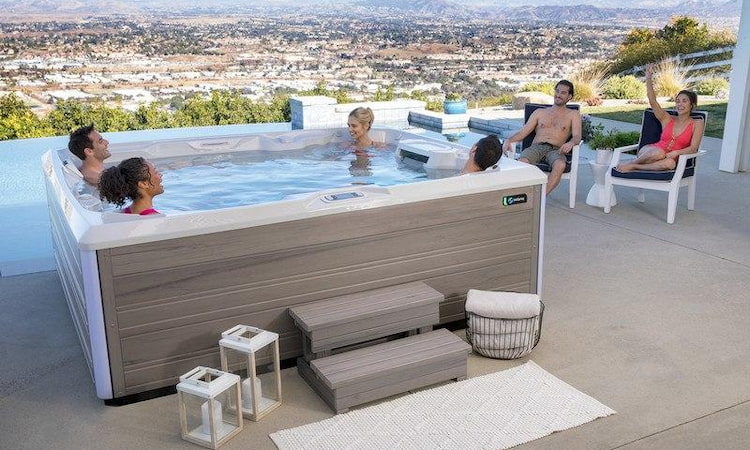
![How Much Electricity Does a Hot Tub Use? [Per Day, Week, Month] how much electricity does hot tub use](https://hottubtales.com/wp-content/uploads/2023/03/how-much-electricity-does-hot-tub-use.jpg)
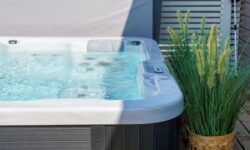
![Is Yellow Hot Tub Water Safe? [& Treatment Options] is yellow water in hot tub safe](https://hottubtales.com/wp-content/uploads/2023/10/is-yellow-water-in-hot-tub-safe-250x150.jpg)
